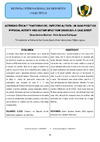Please use this identifier to cite or link to this item:
https://accedacris.ulpgc.es/jspui/handle/10553/112746
| DC Field | Value | Language |
|---|---|---|
| dc.contributor.author | Jiménez Martínez, Elena | en_US |
| dc.contributor.author | Santana Rodríguez, Alicia | en_US |
| dc.date.accessioned | 2021-11-19T10:41:05Z | - |
| dc.date.available | 2021-11-19T10:41:05Z | - |
| dc.date.issued | 2016 | en_US |
| dc.identifier.issn | 1989-841X | en_US |
| dc.identifier.other | Dialnet | - |
| dc.identifier.uri | https://accedacris.ulpgc.es/handle/10553/112746 | - |
| dc.description.abstract | La actividad física influye de forma positiva en la calidad de vida de las personas, lo que hace suponer que su práctica y sus beneficios pueden ser esenciales en los individuos con Trastorno del Espectro Autista. La intervención buscó optimizar la práctica de actividad física de un grupo de jóvenes con autismo, utilizar la misma como instrumento para trabajar su competencia social y autonomía personal y reducir algunas estereotipias propias del trastorno. Para recabar la información se utiliza un método de observación estructurada. Los destinatarios eran escolares de entre 8 y 17 años diagnosticados de Trastorno del Espectro Autista. Los usuarios muestran progresos evidentes, aunque desiguales, debido a sus grandes diferencias cognitivas; no todos alcanzan avances a nivel social. El ejercicio físico parece favorecer en los sujetos la mejora de sus destrezas corporales y sociales, si bien habría que corroborarlo en estudios con más usuarios y más tiempo de seguimiento. | en_US |
| dc.description.abstract | Physical activity has a positive influence on the quality of life, which means that its practice and benefits on individuals with Autism Spectrum Disorder may be essential. The aim of the intervention was to optimize the physical activity in a group of young individuals with autism, in order to use it as a tool to work its social competence and personal autonomy and to reduce some of the typical repetitive behaviours of this disorder. In order to obtain information, a method of structured observation is used. The individuals were school children aged 8 to 17 years old diagnosed with Autism Spectrum Disorder. The users show evident physical progress, but unequal due to the big cognitive differences; not all of them reach social advances. Physical exercise seems to improve the individual´s body and social skills, although this conclusion should be confirmed with researches with a higher number of individuals and a longer follow-up. | en_US |
| dc.language | spa | en_US |
| dc.relation.ispartof | Revista internacional de deportes colectivos | en_US |
| dc.source | Revista Internacional de Deportes Colectivos [ISSN 1989-841X], n. 26, p. 89-100 | en_US |
| dc.subject | 241106 Fisiología del ejercicio | en_US |
| dc.subject.other | Trastorno del Espectro Autista | en_US |
| dc.subject.other | Estereotipias | en_US |
| dc.subject.other | Cognición | en_US |
| dc.subject.other | Actividad física | en_US |
| dc.subject.other | Autism Spectrum Disorder (ASD) | en_US |
| dc.subject.other | Cognition | en_US |
| dc.subject.other | Physical activity | en_US |
| dc.subject.other | Repetitive behaviours | en_US |
| dc.title | Actividad física y trastorno del espectro autista: Un caso práctico | en_US |
| dc.title.alternative | Physical activity and autism spectrum disorder: A case study | en_US |
| dc.type | info:eu-repo/semantics/Article | en_US |
| dc.type | Article | en_US |
| dc.identifier.url | http://dialnet.unirioja.es/servlet/articulo?codigo=7958182 | - |
| dc.description.lastpage | 100 | en_US |
| dc.identifier.issue | 26 | - |
| dc.description.firstpage | 89 | en_US |
| dc.investigacion | Ciencias de la Salud | en_US |
| dc.type2 | Artículo | en_US |
| dc.contributor.authordialnetid | 4638401 | - |
| dc.contributor.authordialnetid | 1967789 | - |
| dc.identifier.dialnet | 7958182ARTREV | - |
| dc.utils.revision | Sí | en_US |
| dc.identifier.ulpgc | Sí | en_US |
| dc.contributor.buulpgc | BU-FIS | en_US |
| dc.description.dialnetimpact | 0,0 | |
| dc.description.dialnetq | Q4 | |
| dc.description.dialnetd | D9 | |
| item.grantfulltext | open | - |
| item.fulltext | Con texto completo | - |
| crisitem.author.dept | Departamento de Educación Física | - |
| crisitem.author.fullName | Santana Rodríguez, Alicia | - |
| Appears in Collections: | Artículos | |
Page view(s)
64
checked on Sep 24, 2022
Download(s)
125
checked on Sep 24, 2022
Google ScholarTM
Check
Share
Export metadata
Items in accedaCRIS are protected by copyright, with all rights reserved, unless otherwise indicated.
